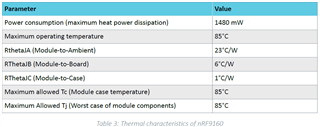Hi,
Referring to White Paper nRF9160 Hardware Design Guidelines v1.0, what is the scenario (supply voltage, band, antenna VSWR, TX duty cycle...) behind maximum heat power dissipation value of 1480mW? We are interested in M1 only without GPS. Does this value represent Gen2 HW with reduced power consumption?
Thanks, JuhaK




